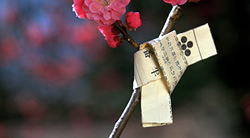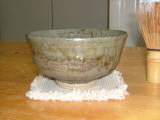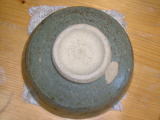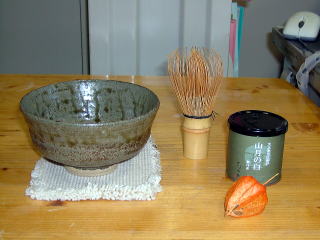茶道は、抹茶を飲み楽しむ事に様々な文化が加わって発展ました。
つまり、茶室や庭など住まいに関する空間、茶道具を選んだり鑑賞したりする工芸、そしてお茶会(茶事〔ちゃごと〕)に出てくる懐石料理や和菓子などの食、客人を気持ちよくもてなすための点前〔てまえ〕作法が融合した総合芸術です。
さらに、茶道は禅宗と深く関わり「わび・さび」という精神文化を生み出しました。
「わび・さび」とは、わびしい、さびしい、という満たされない状態を認め、慎み深く行動することを言います。 茶道においては、この「わび・さび」の精神を大切にし、茶室という静かな空間で茶を点〔た〕てることに集中することで心を落ち着かせます。その事によって自分自身を見直し、精神を高めます。
また、茶道では「一期一会」という言葉があります。これは「人との出会いを一生に一度のものと思い、相手に対し最善を尽くす」という意味の言葉です。
茶道ではこれら精神にのっとってお茶をたてる事を大切にしています。
お茶を飲む風習は、紀元前からすでに中国で行なわれていました。
中国から日本にもたらされたお茶は、ただ飲むことから、礼法・作法を
もった茶の湯へそして茶道へと独自の発展を遂げてきたのです。
茶室とは、茶を饗することを目的として建てられた部屋、建物のことです。「茶事」が催されるためには、茶室のほかに、露地、水屋も必要となります。茶事の目的は、お茶をとおして客をもてなすことであります。
茶室のありようを知るには、「茶事」のことを理解する必要があります。「茶事」を二幕の演劇にたとえられることもあります。初座、後座と小休止の意味合いを持つ中立で構成されています。客と亭主の間で、言葉少なに劇が進行していきます。
初座で、客は露地をつたって茶室へ入ります。「懐石」とよぶ軽い食事、一汁三菜が出された後、炭がつがれます。炭が済むと、客は一旦部屋を出ます。客は露地で次の案内があるまで少し休みます。
後座では、はじめに濃茶がたてられます。その後、炭をなおし薄茶がふるまわれます。全てが終わり客と亭主はお互いにこの一度限りの劇の全てを認識しあいます。
茶室、露地、水屋は、このような茶事を効果的に行なえるよう工夫されています。茶人たちは、限られた空間をいかに美的にまた機能的にできるのかを試みています。
|
|





A chashitsu is a building or a room in which the tea ceremony is performed. The purpose of a chaji, or full tea ceremony, is to allow the host an opportunity to express the utmost hospitality to his or her guests. Together, the chashitsu, roji (tea garden), and mizuya (preparation room) should provide the optimum physical and spiritual setting for expressing this hospitality.
To understand the concepts behind chashitsu design, it is essential to be familiar with the flow of action in a chaji. A chaji is like a play consisting of two acts and an intermission. During this play, the host and guests perform a highly ritualized series of actions, carrying on a nearly wordless dialogue of symbolism and feeling.
In the shoza, or first "act," the guests enter the chashitsu from the roji, and once inside, are served a light meal (kaiseki). Following the meal, the host prepares the charcoal for the first time (shozumi). After shozumi, the guests retire to the garden for a short break, "the intermission," and wait for the host to call them back into the chashitsu.
The second "act" of a chaji is called the goza. First the host prepares koicha (thick tea) for the guests. He then prepares the charcoal a second time (gozumi) and makes usucha (thin tea). When all of this is finished, the host and guests silently and respectfully acknowledge each other one last time, and the guests take their leave.
The design of the chashitsu, roji, and mizuya can have a profound effect upon the flow of action in a chaji. Designers strive for both functionality and aesthetics, and despite a highly complex set of design rules, a nearly infinite number of styles is possible.
We start introducing the main elements that make a chasitsu.